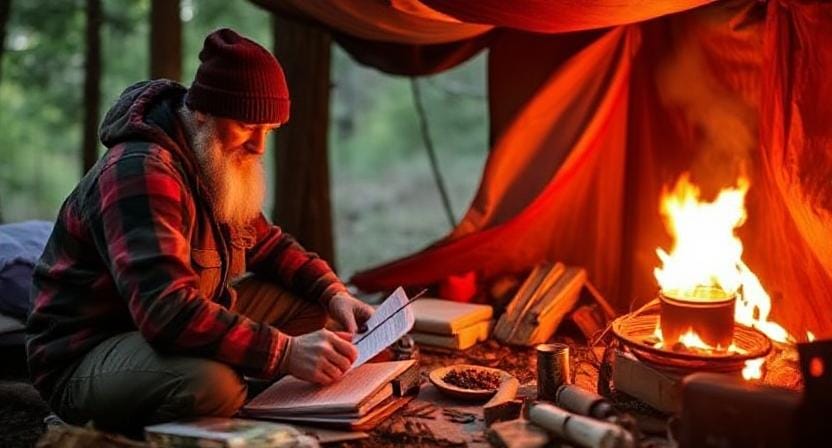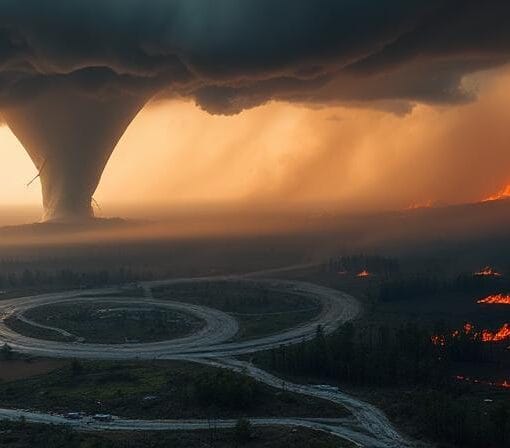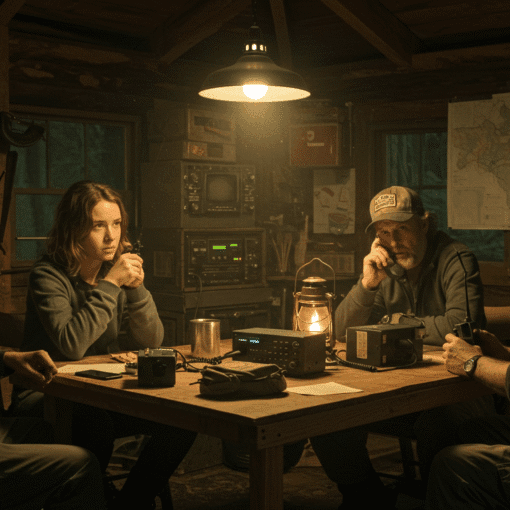Please Note: This post may contain affiliate links. If you click one of them, we may receive a commission at no extra cost to you. As an Amazon Associate, I earn from qualifying purchases.
Top Takeaways and Key Concepts
- Identify your risks based on local threats like storms, earthquakes, or power outages to plan wisely.
- Build a complete emergency kit with food, water, first aid, flashlights, and fresh batteries.
- Create a clear family plan with contact info, meeting spots, and multiple escape routes.
- Stay informed using reliable weather apps and local news instead of unverified social media posts.
- Practice regularly through family drills to stay calm, confident, and ready during real emergencies.
Summary of This Article
This article teaches how to prepare for life’s unpredictable disasters with practical, proactive steps. It emphasizes knowing your local risks, building a reliable emergency kit, creating a clear communication and evacuation plan, and staying informed through trusted sources. Regular practice ensures confidence and teamwork during crises. Ultimately, disaster readiness isn’t about fear—it’s about control, calm, and even finding a little fun in being prepared.
Short Video Version of this Article
Life really can be a wild ride. One minute, you’re sipping your coffee, feeling all cozy. The next, your neighborhood feels like it’s part of a movie about natural disasters. Yikes, right?
So, what do you do to stay safe? Just crossing your fingers and wishing for calm won’t cut it. You need a plan, my friend. Let’s talk about some easy ways to disaster-proof your life.

Start with a little emergency kit. Think of it like your superhero toolbox. Pack things like water, snacks, a flashlight, and, oh, maybe some extra batteries. You never know when you’ll need a snack and some light.
Next, keep important info handy. Write down phone numbers of family or friends. You might want to jot down your doctor’s name, too. Stick it on the fridge. Easy to grab in a pinch.
Practice your plan. Sounds silly? It’s not! Just like a fire drill. Gather your family and talk about what to do. Where would you go if something happened? Teamwork makes it feel less scary.
Now, while prepping, don’t forget to take a breath. It’s easy to get stressed. Enjoy the small moments too. Maybe sip that coffee while you make your list.
You’ll feel so much better knowing you’re ready. It’s like having a safety net. You won’t become part of that “Oh no!” group. You can handle whatever comes your way—even if Aunt Edna shows up unannounced.
So, let’s get cracking! Gather your supplies, make that plan, and take on life’s twists and turns together. You got this!
Step 1 – Know Thy Risks

Let’s be honest for a second. We all know that life can be unpredictable. You wouldn’t wear flip-flops in a snowstorm, would you? That would be a disaster! The first thing you need to do to get ready is to think about what could change your life.
Think about disasters that happen in nature. Are you in an area that gets hurricanes or is close to a fault line? You can make your emergency kit better by knowing this. If you live in a place that receives a lot of storms, you might want to stock up on extra water and snacks that will last. You might want to make sure that bookshelves don’t fall over if there are earthquakes.
Don’t forget about calamities that people cause. They can also sneak up on you. There are times when the power goes off. What do you do when the Wi-Fi goes out? Being without the internet might make you feel like you’re on a deserted island. Does your phone still work? Do you have a spare battery?
It’s all about knowing what could happen. You don’t have to wait for tragedy to knock on your door like an obnoxious salesman. You can customize your prep if you know what your risks are.
Let’s get started. Look around and make plans. Putting even a little work today can make a big difference later. You can do this!
Step 2 – Build Your Emergency Kit

Okay, now that you know that bad things could happen at any moment (queue scary music), let’s speak about supplies. A backpack full of granola bars and expired coupons isn’t enough for an emergency kit. It should be a well-planned weapon against chaos.
This is what you need—
– Water: At least one gallon per person every day for three days. Nothing screams “I’m ready” like remaining hydrated while the world falls apart around you.
– Food that doesn’t go bad, such canned goods, energy bars, and maybe even some consolation treats (chocolate counts). You might not be able to get pizza during the end of the world!
– First aid supplies, like band-aids, antiseptics, and any medicines you need. Do you remember when you stubbed your toe? Yes, don’t do that again without taking care of it.
– Flashlight and batteries: It’s only enjoyable to look for matches in the dark until you can’t find them.
And don’t forget to check the expiration dates every now and then! Finding out that your food cache is full of old peanut butter is the best way to show that you’re ready.
Step 3 – Create an Emergency Plan

It’s time to make a plan now that your materials are all lined up like little soldiers. You wouldn’t go into battle without a plan, would you? The same is true for emergencies.
Consider how you plan to talk to others. What happens if the cell towers stop working? Maybe we should bring back carrier pigeons! Not really. Make a list of crucial phone numbers and keep it safe. So, if your phone dies, you have a backup.
Let’s speak about how to get out of the area next. Where are you going if things get out of hand at home? You need more than one way to get there since, let’s be honest, Google Maps could not be working when you need it. Look for other routes out so you don’t become locked in a panic. You may use parks or streets you know well.
It’s also very crucial to have venues to meet. If family members get separated, they should have places to meet up. For example, if the kids get lost at Disneyland, where should everyone go? Not Grandma’s house unless she lives on a hill! Choose sites that are simple to find, like a monument or a big tree near your house.
This plan keeps everyone calm. It’s like playing a game where everyone knows what to do. You can do this! You can handle anything if you plan ahead.
Step 4 – Stay Informed
Information really is power, especially when Mother Nature gets a bit dramatic. You want to be ready when things go sideways. Find reliable sources that keep you updated on emergencies.
Weather apps are a must-have. Download ones that give real-time alerts for your area. This way, you won’t be caught off guard while you’re still binge-watching cat videos. You’ll know if a storm is on the way, and it’s always better to be safe than sorry.
Don’t forget about local news outlets. They do more than just report the weather. They provide important updates during emergencies, too. You can get the scoop on what’s happening nearby, and that can really help you make smart choices.
Staying informed lets you respond quickly instead of relying on hearsay or social media. Rumors spread faster than wildfire sometimes! You want to cut through all that noise. It feels good to know what’s going on, right? So keep those apps handy and check in on the news. You’ll feel more in control, and that’s a really nice feeling during stressful times.
Step 5 – Practice Makes Perfect
Finally, after all that prepping and planning, it’s time to practice! I know, I know. Practicing can feel as exciting as watching paint dry. But hear me out.
Think about drills. Doing regular drills with your family is super important. Everyone needs to know what to do when panic kicks in. Or when Uncle Bob starts yelling about his missing TV remote during an earthquake drill. Trust me, laughter can help ease the stress.
Check your plans too. Go over them every six months or so. You can do this while munching on snacks or catching up on the latest season of that reality show everyone’s talking about. Make sure your emergency kits are still stocked with goodies, too. You want treats in there, not just old granola bars that taste like cardboard!
Practicing keeps everyone calm and ready. It helps everyone feel good about what to do if things get chaotic. So, grab your family, have some fun, and practice together. You’ll feel a lot better when you know you’re all set for anything!
Getting ready for disasters doesn’t have to be scary or like a big job. It can really be enjoyable, though! Picture this: you and your family are sitting around eating popcorn and putting together your survival packs. It’s like going on an adventure!
With these tips and maybe some snacks tucked away, you’ll be ready for anything that comes your way. Give it some thought. When life throws you curveballs, being ready means you can not only get through them, but also do well.
Having supplies isn’t the only thing that makes you disaster-proof. It’s about making the most of every day, even when nature acts up or that one family member comes up without warning.
You may enjoy life more when you’re ready for anything. Imagine a day at the beach even though it suddenly started to rain, or a holiday dinner with company you weren’t expecting. You’ll be able to handle everything. And don’t forget to have some fun while you get ready! It’s all part of the fun.
Featured Snippet: Preparing for emergencies is about being proactive, not panicked. By identifying local risks, assembling a complete emergency kit, and creating a practiced family plan, you can stay calm and confident when disaster strikes. Preparation isn’t fear—it’s smart living and peace of mind.
Frequently Asked Questions
How can I identify the biggest risks in my area?
Start by checking local emergency management websites or news outlets for common hazards like floods, storms, or earthquakes. Knowing your local risks helps you plan effectively and prioritize your supplies.
What should I include in an emergency kit?
Pack essentials such as water, non-perishable food, first aid supplies, flashlights, batteries, and important documents. Review and update your kit every few months to replace expired items.
How often should I practice my emergency plan?
Conduct family drills at least twice a year to reinforce routines and reduce panic during real emergencies. Use these drills to review meeting spots, contacts, and evacuation routes.
Why is staying informed during a disaster important?
Real-time information helps you make smart, safe decisions. Use trusted weather apps and local broadcasts instead of relying on social media rumors or unverified updates.
What’s the best way to communicate if phones stop working?
Prepare a written contact list and agree on alternative methods like walkie-talkies or meeting points. This ensures you can reconnect even if cell service fails.
How do I keep kids calm during emergencies?
Involve them in planning and drills so they feel confident. Keep small comfort items or snacks in your emergency kit to provide reassurance during stressful moments.
What’s one simple habit to stay prepared year-round?
Review your plan and supplies every six months. Add seasonal items like warm clothing or sunscreen, and replace anything outdated or worn out.

Kevin Collier is a seasoned outdoor enthusiast and writer for Trekbug.com, specializing in outdoor adventures, survival strategies, and prepping insights. With a deep love for nature and a commitment to self-sufficiency, Kevin empowers readers to embrace the wilderness confidently. He shares valuable tips, practical techniques, and inspiring stories, helping both novice and experienced adventurers develop essential skills for surviving and thriving in the great outdoors.




